The Largest Airport Terminals in the World: Massive Structures That Move Millions
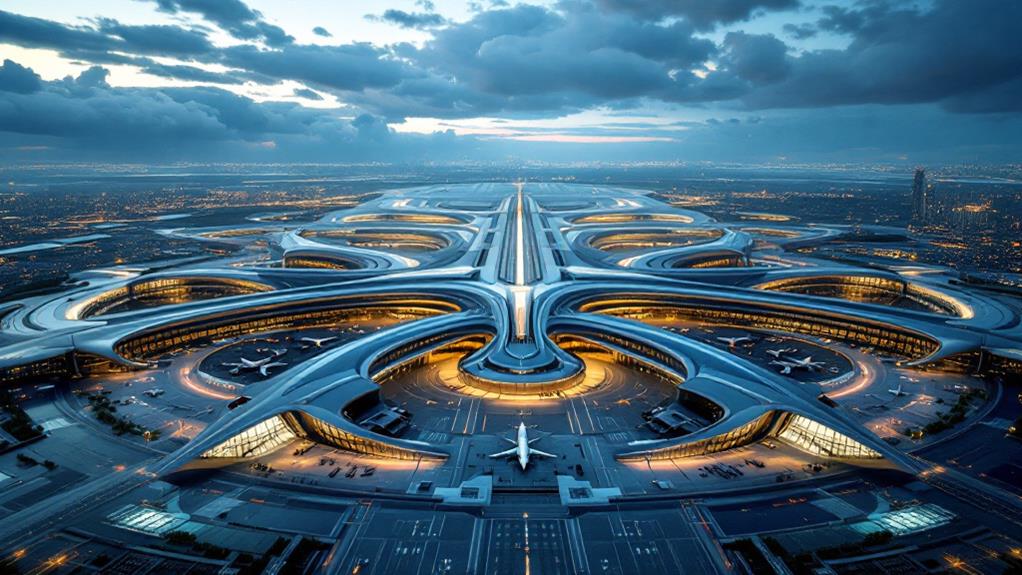
Imagine standing in one of the world's largest airport terminals, like Istanbul Airport, which spans 1.4 million square meters and is built to handle 90 million passengers annually, with plans for 200 million. Then, there's Al Maktoum International aiming to accommodate over 220 million passengers each year with a $32.67 billion expansion. The starfish-designed Beijing Daxing covers 700,000 square meters, showcasing cutting-edge smart technologies. These colossal structures aren't just about size, but also about innovation, economic impact, and sustainability. You're on the verge of uncovering more about these wonders and the future trends shaping aviation.
Key Global Airport Projects
Global airport projects are transforming air travel, with several ambitious developments underway. You're witnessing a shift in the aviation landscape, driven by the need to accommodate growing passenger volumes. Istanbul Airport stands out with its vast terminal area of 1.4 million square meters. Initially designed for 90 million passengers, it's set to expand considerably, showcasing one of the largest airport construction projects globally. Likewise, Beijing Daxing International Airport, with its $13 billion investment, is a marvel of efficiency, handling 72 million passengers annually with eight runways facilitating seamless operations.
In Vietnam, Long Thanh International Airport represents an ambitious vision, with its initial phase planned for 25 million passengers and future expansions aiming for 100 million by 2050. This project emphasizes the strategic development of passenger capacity to meet future demands. On a grander scale, Al Maktoum International Airport in Dubai aspires to be the largest worldwide, projecting an astounding capacity of over 220 million passengers annually, backed by a $32.67 billion investment.
Heathrow Airport's expansion includes adding a third runway, enhancing its capacity from 85.5 million to 130 million passengers annually. These projects redefine air travel, illustrating the immense scale and ambition shaping the future of aviation.
Expansion and Capacity Goals
As airport projects worldwide reshape the aviation landscape, their expansion and capacity goals are at the forefront of this transformation. You're witnessing remarkable infrastructure projects that aim to redefine what it means to be the largest and busiest airport on the planet. Take the Istanbul Airport, for example. Once completed, it aims to achieve a staggering annual capacity of 200 million passengers, positioning it as the world's busiest airport. Meanwhile, in the UK, Heathrow's expansion is set to increase its capacity considerably. By adding a third runway, it's expected to serve up to 130 million passengers annually by 2026.
You're also seeing ambitious plans in Dubai with the Al Maktoum International Airport. This $33 billion expansion project seeks to accommodate over 220 million passengers each year. It's one of the largest airport infrastructure projects globally. In Asia, Vietnam's Long Thanh International Airport is developing in phases. Initially, it'll handle 25 million passengers per year, with a plan to expand to 100 million by 2050. Singapore's Changi Airport is also making moves with its Terminal 5 expansion, projected to increase capacity by 50 million passengers annually in the mid-2030s. These projects are setting new standards in aviation capacity and efficiency.
Innovative Terminal Designs
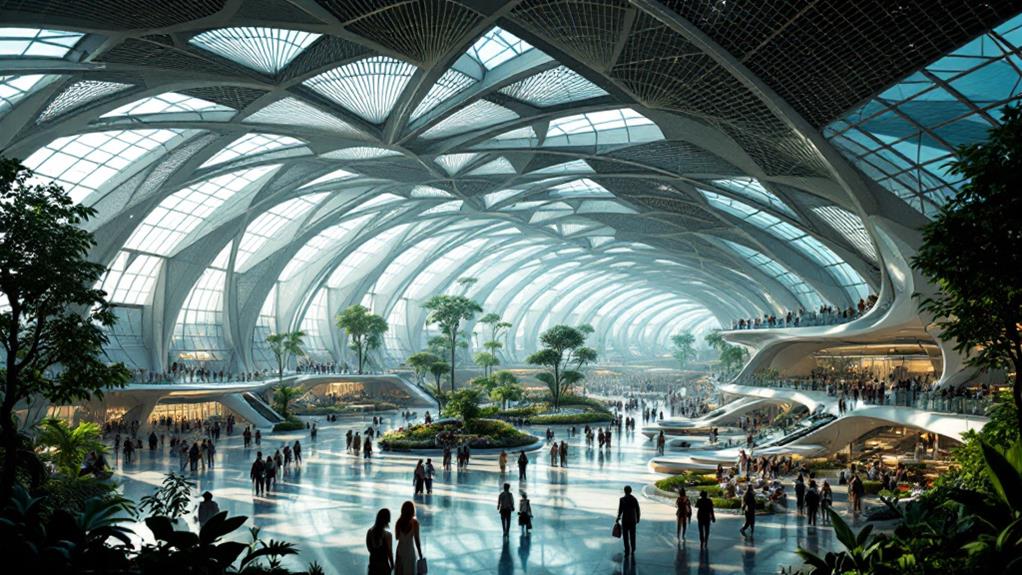
In recent years, airports worldwide have adopted cutting-edge terminal designs to improve passenger experience and operational efficiency. These groundbreaking terminal designs are transforming the way you travel, making your trip smoother and more enjoyable. Take Istanbul Airport for example, where the initial phase of its terminal building spans 1.4 million square meters, capable of handling 90 million passengers annually. This passenger terminal is not just massive; it's designed to scale up to accommodate 200 million passengers, making it one of the largest airport projects globally.
In Mexico City, the X-shaped terminal design stretches over 100 meters, boasting a total area of 6 million square feet, ensuring efficient passenger flow and integration with air traffic control. This design advancement helps you move seamlessly between gates and ground transportation hubs. Meanwhile, Beijing Daxing International Airport, with its starfish layout, covers 700,000 square meters, providing a unique and efficient passenger experience.
Singapore's Changi Airport Terminal 5, set to open in the mid-2030s, will further exemplify these advancements by enhancing capacity for an extra 50 million passengers annually. Ultimately, Dubai's Al Maktoum International Airport expands its facilities to host over 220 million passengers, solidifying its place among the largest airport projects worldwide.
Economic and Job Benefits
With airports expanding, they're not just improving air travel but also driving economic growth and job creation. By building larger terminals, airports like Los Angeles International Airport are setting the stage for considerable economic benefits. The modernization plan at LAX, the city's largest public works project, is expected to increase local job creation and greatly improve the economy. As more passengers pass through these hubs, local businesses thrive, spurring further economic growth.
Take Long Thanh International Airport in Vietnam as another example. It aims to create around 100,000 jobs during its construction and operational phases. This massive project will considerably bolster the local economy, improving living standards and creating more opportunities for the community. Likewise, Istanbul Airport, with its ambitious expansion, is projected to generate approximately 225,000 jobs, highlighting its considerable impact on regional employment.
Globally, major airport projects, valued at $737.3 billion, are forecasted to yield considerable economic benefits. The U.S. alone plans to invest up to $70 billion in over 50 airport projects. Such investments not only accommodate more passengers but also strengthen the economic fabric through increased job creation and tourism.
Technological Advancements
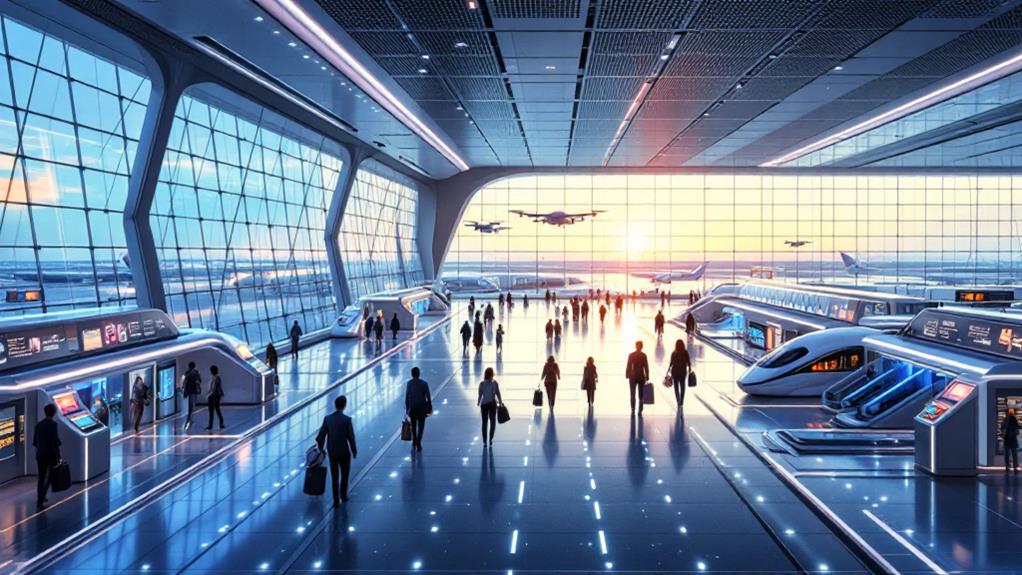
Technological innovations are transforming the way airport terminals operate, making travel smoother and more efficient for passengers. Imagine walking through modern terminal buildings like Istanbul Airport, where advanced smart systems greet you. These systems use AI and facial recognition to speed up passenger processing, ensuring you spend less time in lines and more time relaxing. With advanced baggage handling systems capable of processing nearly 30,000 bags per hour, you can trust that your luggage will travel as efficiently as you do.
Airports will be able to offer you a seamless experience, thanks to extensive cabling networks. At Istanbul Airport alone, 4,500 km of cabling supports the technological infrastructure, enabling reliable connectivity and communication. Automated services are becoming a staple, offering you conveniences like early baggage storage. These advancements not only make your travel more pleasant but also drastically improve the efficiency of airport operations.
Moreover, terminal buildings are integrating facilities such as lounges, hospitals, and convention centers. These enhancements improve passenger convenience, allowing you to enjoy a range of services without leaving the airport. With these technological advancements, your travel experience is set to become more streamlined and enjoyable.
Environmental Sustainability Efforts
A growing number of airports worldwide are embracing environmental sustainability efforts to minimize their ecological footprint. Airports like Istanbul and Heathrow are leading the way with ambitious sustainability initiatives. At Istanbul Airport, energy-efficient designs and advanced waste management systems play a crucial role in reducing environmental impact. You'll find green technologies such as solar panels and rainwater harvesting systems integrated into airport operations, greatly improving their carbon footprint.
Heathrow Airport's expansion plans are remarkable for their focus on reducing carbon emissions and improving noise management. These efforts align with environmental regulations and address community concerns, ensuring airports operate sustainably. The emphasis on natural light and ventilation is another key trend. Changi Airport Terminal 5 exemplifies this approach, prioritizing these elements to cut down energy consumption and improve passenger comfort.
Airports aren't just focusing on internal operations; they're actively engaging with local communities to address broader environmental concerns. Strategies for habitat preservation and biodiversity improvement are now integral to airport expansions. By incorporating these practices, airports endeavor to create a balanced relationship with the surrounding ecosystem, demonstrating a commitment to sustainable growth and environmental stewardship.
Challenges and Considerations
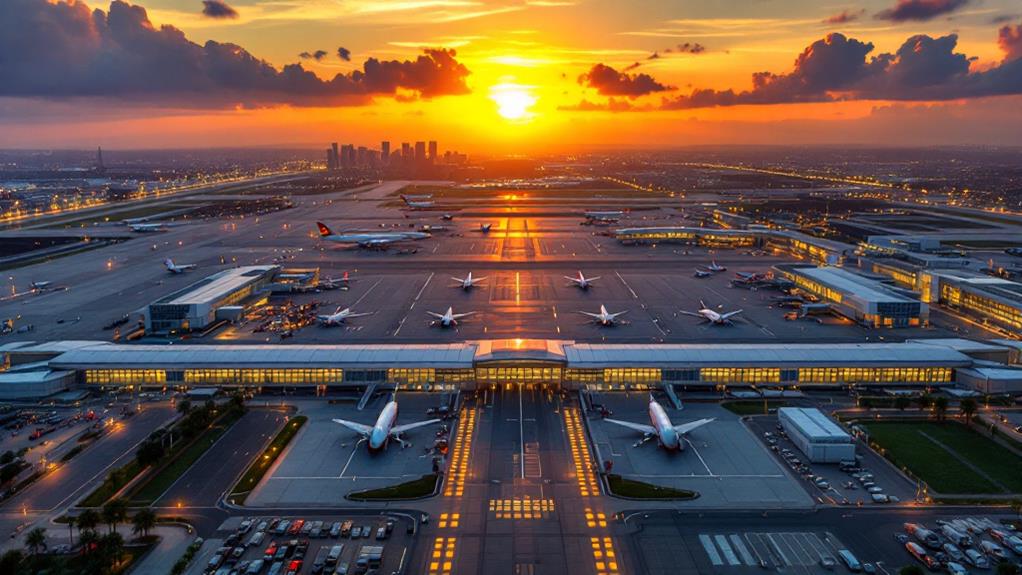
As airports endeavor to become more environmentally sustainable, they face a myriad of challenges and considerations in constructing large terminals. One major hurdle is securing adequate funding. Projects like Long Thanh International Airport in Vietnam illustrate the financial strain, with site clearance complications inflating costs by an estimated $1 billion. These financial challenges can lead to delays in project timelines, as seen with Heathrow Airport's expansion, casting doubt on the feasibility of meeting deadlines.
Environmental considerations add another layer of complexity. Airports must manage noise and emissions to comply with regulatory standards, which can greatly impact the project's scope and design. Community engagement becomes crucial in addressing local concerns and gaining approval for these massive undertakings. If you don't successfully involve the community, you risk facing opposition that could stall progress.
Relocation presents a sensitive issue, too. Long Thanh's project requires moving approximately 5,000 residents, highlighting the social challenges involved. Balancing these relocations with environmental and financial constraints is no small feat. In maneuvering these waters, you must carefully evaluate each factor, ensuring that all considerations are aligned to successfully push the project forward without losing sight of sustainability goals.
Impact of Global Competition
In the current interconnected world, major airports are racing to capture international passenger traffic, turning expansions into a battleground for global dominance. With Istanbul Airport's ambitious expansion project aiming to handle up to 200 million passengers annually, it's set to become the world's busiest airport. This move highlights the intense competition among global airports to secure a competitive edge. Similarly, Dubai International Airport's Al Maktoum expansion plans to enhance its capacity to over 220 million passengers annually, further cementing its status as a leading aviation hub.
The global airport construction market, valued at a staggering $737.3 billion, underscores the massive investments fueling this competitive race. Major airports aren't just expanding; they're innovating to draw more passenger traffic. For instance, Heathrow Airport's $18.5 billion expansion project will increase its capacity to 130 million passengers, improving its standing in Europe.
In the Asia-Pacific region, $241.4 billion is being invested in airport projects, reflecting a concentrated effort to raise regional hubs. These expansions are crucial in the quest for global connectivity, as airports aim to become indispensable nodes in the global transportation network, vying fiercely for international travelers.
Future Trends in Aviation
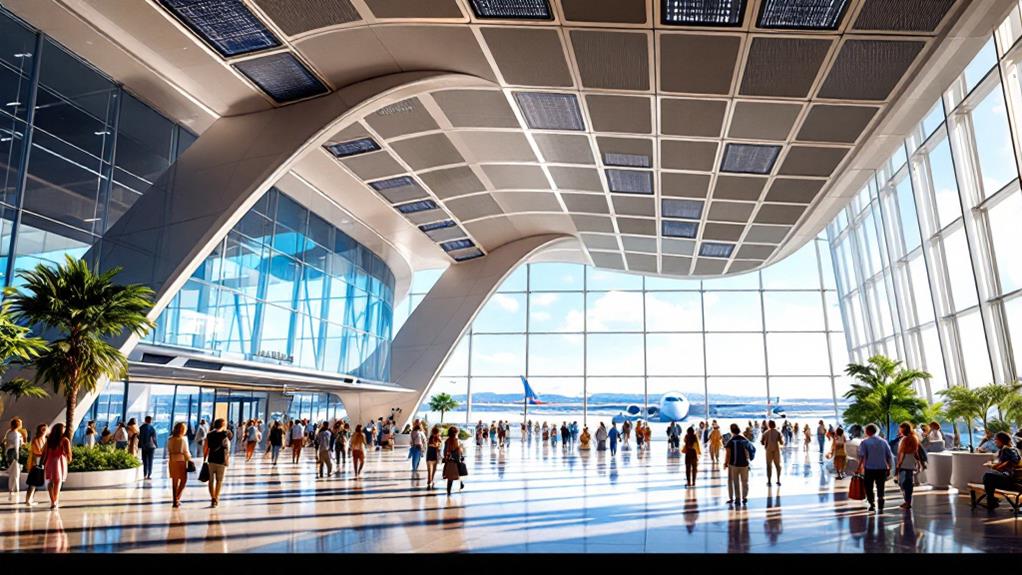
With global airports fiercely competing to dominate passenger traffic, the aviation industry is gearing up for future trends that promise to reshape how we travel. As the demand for air travel rebounds, airports worldwide, including the airport in Ho Chi Minh City, are preparing for major expansions. These expansions aim to accommodate millions of passengers a year and are vital for staying competitive in a rapidly evolving landscape.
One key trend is the integration of smart technologies. Airports are adopting AI-driven systems and automated services to streamline operations and improve passenger experience. Imagine checking in, passing security, and boarding your flight with minimal human interaction—it's a future that's quickly becoming reality.
Sustainable aviation practices are also at the forefront, with investments in green technologies helping to reduce the environmental impact. This shift is not only beneficial for the planet but also fundamental for long-term economic growth. Airports are becoming economic hubs, driving job creation and enhancing local economies.
Health and safety protocols have taken center stage, too. Future airport designs are focusing on resilience, ensuring that facilities can adapt to new health challenges while maintaining high safety standards. These trends collectively signal an exciting transformation for global aviation.



